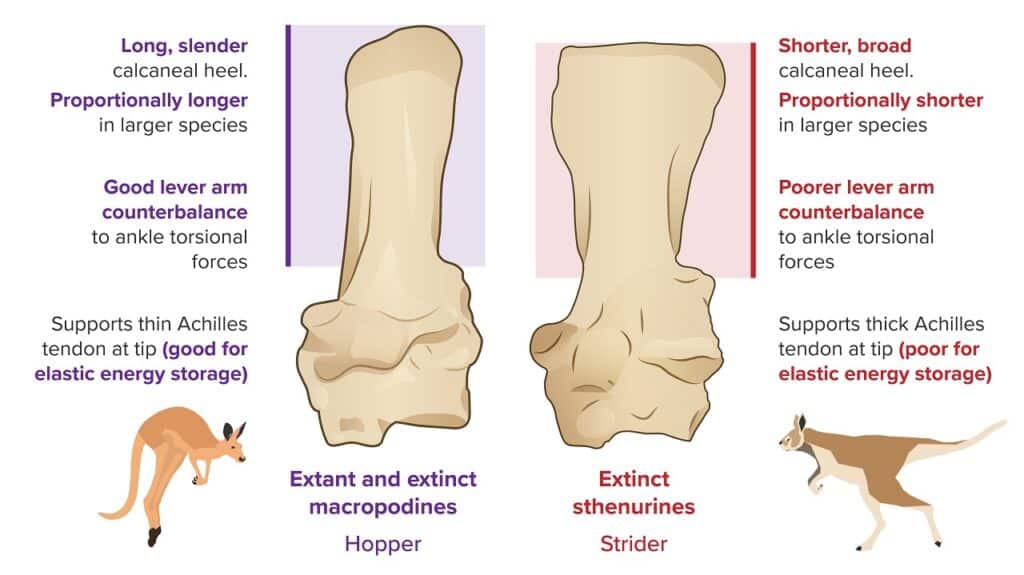Researchers from the University of Bristol and the University of Uppsala found that extinct kangaroos used alternative methods to hop. The new study shows there are alternative ways to be an evolutionarily successful large kangaroo and that large-bodied kangaroos were not just specialized in endurance hopping.
Hopping is regarded as a pinnacle of kangaroo evolution. It began in small-bodied forms. However, as larger kangaroos emerged in the late Miocene, they could specialize in endurance hopping or adopt other forms of locomotion at higher speeds. Protemnodons, related to modern large kangaroos, primarily relied on quadrupedal locomotion and rarely hopped. The stearine short-faced kangaroos, a lineage that split from all modern kangaroos around 15 million years ago, adopted bipedal striding at all speeds.
The researchers highlight that other large kangaroos likely moved differently in the not-too-distant past, such as striding on two legs or traversing on all fours. The fossil record shows that some extinct kangaroos had compared to diversified locomotory capacities, whereas nearly all living kangaroos, small and big, used hopping gaits to some level nowadays.
The discussion of the fossil evidence of the locomotion of kangaroos and their relatives (including wallabies, tree kangaroos, rat kangaroos, etc.) over the last 25 million years. It presents new limb and ankle bone metric data analyses that add weight to previous locomotor hypotheses.
They suggested that the higher speed-endurance hopping characteristic of current large-bodied kangaroos was likely rare or missing in all but a few large-bodied lineages, including the direct ancestors of present large kangaroos such as red and grey kangaroos. However, the diversity of kangaroo gaits vanished with the Late Pleistocene extinctions of bigger animals.

The earliest kangaroos likely used quadrupedal bounding, climbing, and slower-speed hopping as their primary modes of locomotion. All kangaroos use quadrupedal locomotion at slow speeds, manifesting as pentapedal locomotion in larger species. However, all these early forms were small-bodied, below 12kg, with larger-bodied kangaroos over 20kg appearing in the late Miocene (around 10 million years ago), coinciding with increasing aridity and the spread of openly vegetated habitats.
Some members of the later kangaroo radiation have more specialized anatomy for effective higher-speed hopping at body weights beyond 35 kg because hopping is functionally problematic at larger body sizes. Although most large kangaroos currently weigh less than 70 kg (and none weigh more than 100 kg), several ancient species were much larger and physiologically incapable of hopping.
Lead author Professor Christine Janis from Bristol’s School of Earth Sciences said, “We want people to appreciate that large kangaroos were much more diverse as recently as 50 thousand years ago, which may also mean that the habitat in Australia then was rather different from today. Modern large hopping kangaroos are the exception in kangaroo evolution.“
The new findings on the lengths of the tibia (shin bone) and calcaneum (ankle bone) in these two extinct taxa support previous assumptions of locomotor differences from extant kangaroos.
Professor Janis concluded, “The assumption that increasing continent-wide aridity after the end of the Miocene selectively favored hopping kangaroos is overly simplistic. Hopping is only one of many gait modes employed by kangaroos both in the past and today, and the fast endurance hopping of modern kangaroos should not be regarded as some “evolutionary pinnacle.”
Journal Reference:
- Christine M. Janis, Adrian M. O’Driscoll, et al. The myth of the QANTAS leap: perspectives on the evolution of kangaroo locomotion. Alcheringa: An Australasian Journal of Palaeontology. DOI: 10.1080/03115518.2023.2195895
